Cold weather has finally come to Shibui Bonsai and many of the deciduous bonsai have lost leaves. I always find this a great time of year because I now get to see the underlying structure of branches and twigs that make up my bonsai. I now get the opportunity to assess the branch structure that has been hidden by a dense canopy of leaves for several months and to begin winter pruning and refinement.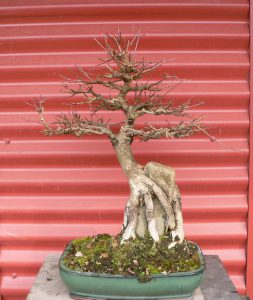 This Root over rock trident maple has a well ramified branch structure. It was my second attempt at root over rock bonsai and is around 28 years old now.
This Root over rock trident maple has a well ramified branch structure. It was my second attempt at root over rock bonsai and is around 28 years old now.
With younger trees we spend a lot of time and effort on increasing ramification but there comes a time when the tree reaches a stage where further ramification is counterproductive and we need to switch from pruning to increase branching (development) to thinning and reducing the branch structure (maintenance)
This trident has been in the maintenance phase for some years now and has a complex branch structure but you can see in the picture above that some areas don’t look quite right. There are also a couple of branches that have grown during the summer that will probably cause further problems if left as they are.
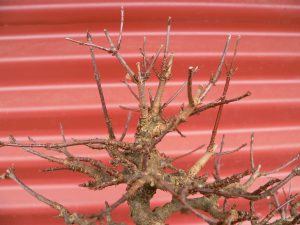
Apex: the upper parts of many trees are the strongest. This is referred to as apical dominance. The trees divert more energy and food to the upper shoots to try to reach maximum height as quickly as possible but for bonsai these strong growing upper shoots not only spoil the look of the tree but can also cause the upper trunk to thicken excessively and must be corrected.
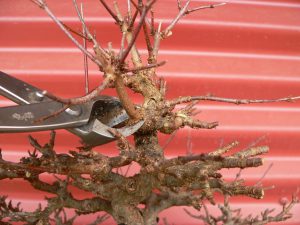 I’ve selected the best placed one of these shoots to be the apex of the tree for next season and shortened it so the leader is now a thinner side shoot.
I’ve selected the best placed one of these shoots to be the apex of the tree for next season and shortened it so the leader is now a thinner side shoot.
I also remove any thicker branches that might compete with the apex or cause the whole area to thicken.
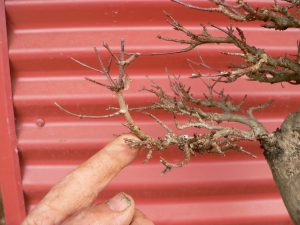 Some of the lower branches have developed strong, thick shoots, especially near the tips. I’m taking the opportunity to remove these. As in the apex, leaving strong parts could lead to excessive thickening and destroy the delicate branching. It is also an opportunity to reduce the length of the branches and bring the width of the silhouette back a little.
Some of the lower branches have developed strong, thick shoots, especially near the tips. I’m taking the opportunity to remove these. As in the apex, leaving strong parts could lead to excessive thickening and destroy the delicate branching. It is also an opportunity to reduce the length of the branches and bring the width of the silhouette back a little.
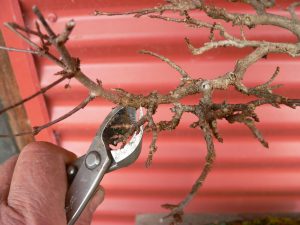 If this is not done occasionally the bonsai would get slightly larger each year.
If this is not done occasionally the bonsai would get slightly larger each year.
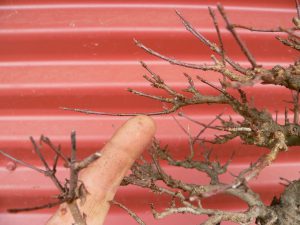 Shoots with long internodes should always be pruned. Even if you are still developing branching, shoots with long internodes should be trimmed. You cannot get intricate ramification if the branches have long, bare spaces so cut these off and try again for shoots with shorter internodes.
Shoots with long internodes should always be pruned. Even if you are still developing branching, shoots with long internodes should be trimmed. You cannot get intricate ramification if the branches have long, bare spaces so cut these off and try again for shoots with shorter internodes.
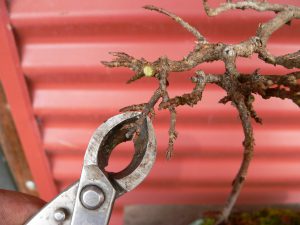 Most bonsai growers are aware that bar branches on the trunk are undesirable but far fewer understand the importance of also removing bar branching from the secondary and tertiary branch structure. Branches or shoots that are opposite not only disturb the visual flow but will also ultimately cause localised thickening so I make a final check to restore the 2×2 branching structure. Wherever possible when I find a branch junction with more than 2 shoots I remove one or more until only 2 remain. In the picture I’ve decided to prune the centre shoot because it is both stronger and long but removing either of the side shoots would also restore the 2×2 structure here.
Most bonsai growers are aware that bar branches on the trunk are undesirable but far fewer understand the importance of also removing bar branching from the secondary and tertiary branch structure. Branches or shoots that are opposite not only disturb the visual flow but will also ultimately cause localised thickening so I make a final check to restore the 2×2 branching structure. Wherever possible when I find a branch junction with more than 2 shoots I remove one or more until only 2 remain. In the picture I’ve decided to prune the centre shoot because it is both stronger and long but removing either of the side shoots would also restore the 2×2 structure here.
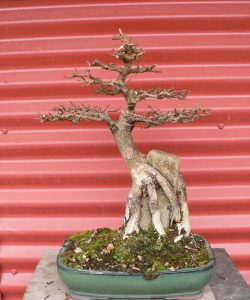 After trimming and pruning the bonsai looks far better and is now ready for spring growth. Contact Shibui Bonsai if you are interested in adding this trident to your bonsai collection. Asking price $1100 + delivery cost.
After trimming and pruning the bonsai looks far better and is now ready for spring growth. Contact Shibui Bonsai if you are interested in adding this trident to your bonsai collection. Asking price $1100 + delivery cost.
Photographed from the front like this the branch structure does not show up well.
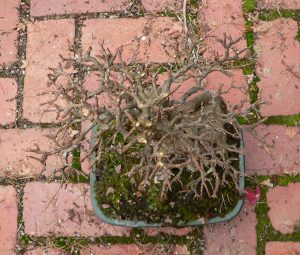 From above you can start to appreciate the intricacy of the ramification.
From above you can start to appreciate the intricacy of the ramification.
